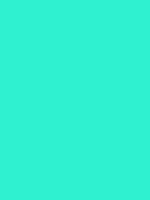#2ff1d0 Color Information
In a RGB color space, hex #2ff1d0 is composed of 18.4% red, 94.5% green and 81.6% blue. Whereas in a CMYK color space, it is composed of 80.5% cyan, 0% magenta, 13.7% yellow and 5.5% black. It has a hue angle of 169.8 degrees, a saturation of 87.4% and a lightness of 56.5%. #2ff1d0 color hex could be obtained by blending #5effff with #00e3a1. Closest websafe color is: #33ffcc.
-
- R 18
- G 95
- B 82
-
- C 80
- M 0
- Y 14
- K 5
● #2ff1d0 color description : Bright cyan.
#2ff1d0 Color Conversion
The hexadecimal color #2ff1d0 has RGB values of R:47, G:241, B:208 and CMYK values of C:0.8, M:0, Y:0.14, K:0.05. Its decimal value is 3142096.
| Hex triplet | 2ff1d0 | #2ff1d0 |
|---|---|---|
| RGB Decimal | 47, 241, 208 | rgb(47,241,208) |
| RGB Percent | 18.4, 94.5, 81.6 | rgb(18.4%,94.5%,81.6%) |
| CMYK | 80, 0, 14, 5 | |
| HSL | 169.8°, 87.4, 56.5 | hsl(169.8,87.4%,56.5%) |
| HSV (or HSB) | 169.8°, 80.5, 94.5 | |
| Web Safe | 33ffcc | #33ffcc |
| CIE-LAB | 86.039, -53.007, 2.914 |
|---|---|
| XYZ | 44.009, 68.065, 70.489 |
| xyY | 0.241, 0.373, 68.065 |
| CIE-LCH | 86.039, 53.087, 176.854 |
| CIE-LUV | 86.039, -67.031, 12.947 |
| Hunter-Lab | 82.501, -49.16, 7.093 |
| Binary | 00101111, 11110001, 11010000 |
Color Schemes with #2ff1d0
Alternatives to #2ff1d0
Below, you can see some colors close to #2ff1d0. Having a set of related colors can be useful if you need an inspirational alternative to your original color choice.
#2ff1d0 Preview
This text has a font color of #2ff1d0.
<span style="color:#2ff1d0;">Text here</span>This paragraph has a background color of #2ff1d0.
<p style="background-color:#2ff1d0;">Content here</p>This element has a border color of #2ff1d0.
<div style="border:1px solid #2ff1d0;">Content here</div>.text {color:#2ff1d0;}.background {background-color:#2ff1d0;}.border {border:1px solid #2ff1d0;}Shades and Tints of #2ff1d0
A shade is achieved by adding black to any pure hue, while a tint is created by mixing white to any pure color. In this example, #010d0b is the darkest color, while #f9fffe is the lightest one.
-
#010d0b
#010d0brgb(1,13,11) -
#021f1a
#021f1argb(2,31,26) -
#033129
#033129rgb(3,49,41) -
#054439
#054439rgb(5,68,57) -
#065648
#065648rgb(6,86,72) -
#076858
#076858rgb(7,104,88) -
#087b67
#087b67rgb(8,123,103) -
#0a8d77
#0a8d77rgb(10,141,119) -
#0ba086
#0ba086rgb(11,160,134) -
#0cb296
#0cb296rgb(12,178,150) -
#0dc4a5
#0dc4a5rgb(13,196,165) -
#0ed7b5
#0ed7b5rgb(14,215,181) -
#10e9c4
#10e9c4rgb(16,233,196)
-
#1df0cc
#1df0ccrgb(29,240,204) -
#2ff1d0
#2ff1d0rgb(47,241,208) -
#41f2d4
#41f2d4rgb(65,242,212) -
#54f3d8
#54f3d8rgb(84,243,216) -
#66f5dc
#66f5dcrgb(102,245,220) -
#79f6e1
#79f6e1rgb(121,246,225) -
#8bf7e5
#8bf7e5rgb(139,247,229) -
#9df8e9
#9df8e9rgb(157,248,233) -
#b0faed
#b0faedrgb(176,250,237) -
#c2fbf1
#c2fbf1rgb(194,251,241) -
#d4fcf5
#d4fcf5rgb(212,252,245) -
#e7fdfa
#e7fdfargb(231,253,250) -
#f9fffe
#f9fffergb(249,255,254)
Tones of #2ff1d0
A tone is produced by adding gray to any pure hue. In this case, #8d9392 is the less saturated color, while #26fad6 is the most saturated one.
-
#8d9392
#8d9392rgb(141,147,146) -
#849c98
#849c98rgb(132,156,152) -
#7ca49d
#7ca49drgb(124,164,157) -
#73ada3
#73ada3rgb(115,173,163) -
#6bb5a9
#6bb5a9rgb(107,181,169) -
#62beae
#62beaergb(98,190,174) -
#5ac6b4
#5ac6b4rgb(90,198,180) -
#51cfb9
#51cfb9rgb(81,207,185) -
#49d7bf
#49d7bfrgb(73,215,191) -
#40e0c5
#40e0c5rgb(64,224,197) -
#38e8ca
#38e8cargb(56,232,202) -
#2ff1d0
#2ff1d0rgb(47,241,208) -
#26fad6
#26fad6rgb(38,250,214)
Color Blindness Simulator
Below, you can see how #2ff1d0 is perceived by people affected by a color vision deficiency. This can be useful if you need to ensure your color combinations are accessible to color-blind users.
